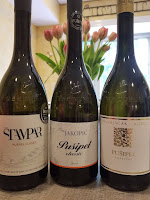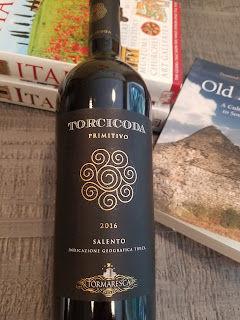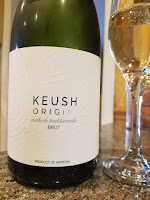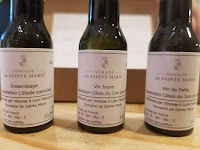"The first records of Pušipel originate from the first half of the 19th century when it was mentioned in the vineyards in the village Dragoslavec Breg. However, after that, the name Pušipel disappeared because it was produced under the name Šipon or Moslavac. This grape variety is also known as the Furmint in Hungary and Mosler in Austria and Germany." - Wine & more.
Continental Croatia is home to several small wine regions with Zagorje and Međimurje bordering Slovenia to the west and very close to Hungary to the north. Međimurje lies between the Drava and Mura rivers and is where the first gentle slopes of the Alps begin. The region has a typical continental climate, with cold winters and hot summers as well as a fairly high level of humidity. That being said, these northwestern regions are the coldest in Kontinentalna Hrvatska and are known for more aromatic grape varietals such as Sauvignon Blanc, Muškat, and Rhine Riesling. But Međimurje is best known for one variety: Pušipel otherwise known as Furmint in Hungary with other synonyms being Mosler, Sipon, Moslovac, and Zapfner.
 The Furmint grape is best known in Tokaj, Hungary where its late-ripening character makes it susceptible to botrytis and leads to the exceptional blended Tokaji Aszú sweet wines. Yet the grape can also be vinified into dry, single-varietal, and minerally driven wines such as Hungary's Somlo region and richer more elegant wines in Croatia's Međimurje.
The Furmint grape is best known in Tokaj, Hungary where its late-ripening character makes it susceptible to botrytis and leads to the exceptional blended Tokaji Aszú sweet wines. Yet the grape can also be vinified into dry, single-varietal, and minerally driven wines such as Hungary's Somlo region and richer more elegant wines in Croatia's Međimurje.  2018 Jakopić Pušipel Classic ($25)
2018 Jakopić Pušipel Classic ($25)This Jakopić wine pedigree began in 1908 when great-grandfather Philip produced his first wines. This had lead to three generations of winemakers within their estate in Železna Gora, Međimurje. Their Pušipel vines were planted 45 years ago in sand and clay soils. This results in a wine that starts with an earthy apple and pear nose that continues into the full mouthfeel with a little lime. And expect a long satisfying finish.
 2019 Stampar Pušipel Classic ($25)
2019 Stampar Pušipel Classic ($25)In 1928, Bolfenk Štampar marries into the family of winemaker Andraš Novak and acquires the estate and cellar that would become Vinarija Štampar. Forty years later, his successor Franjo Štampar plants Pušipel on the Krpec hill - an area of steep inclines dominated by clay with occasional marl, sediment, sparse layers of sandstone, and thin layers of black soil. These plantings expanded with the purchase of the terraced plots on Mađerkin hill. Today, the winery is operated by the 4th generation of Štampars with the Pušipel Classic a showcase wine. It starts with a pleasant herbal, citrus, and floral nose which leads to a well-rounded mouthfeel of citrus and stone fruits. The acidity is sufficient to lift the finish but not overwhelm the palate.
 2017 Dvanajščak-Kozol Pušipel Prestige ($39)
2017 Dvanajščak-Kozol Pušipel Prestige ($39)Vina DK - Dvanajščak Kozol is a family-run operation that cultivates 10 hectares of vineyards below Mohokos (344 m above sea level) and the highest and sunniest part of Međimurje. These vineyards were initially planted in the early 1990s and include the first Pinot Noir cultivated in Međimurje. The winery is run by Viktor and Rajka Dvanajščak (both sommeliers) plus their children Tea (the youngest person to pass the sommelier exam in Croatia at 16 years old) and Viktor (a former med student). This wine has a deeper bright pear and apple profile with a full mouthfeel, depth, and suitable acidity. An excellent wine.
Disclosure: We received samples from Croatian Premium Wine Imports in order to share our opinion about their products, but this isn’t a sponsored post.


































